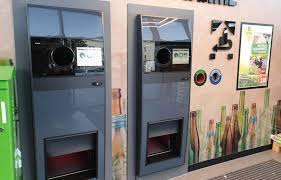Recycling in Bonn: The Struggle of Knowing Which Bin to Use
Bonn, and the rest of Germany for that matter, has quite the intricate recycling infrastructure in place and it can get confusing at times. In Germany, there are four color-coded trash bins, which can get quite confusing to someone who has not been to the country before. The bins are: the yellow bin, Gelbe Tonne, is meant for packaging materials, including plastics, aluminum, and composite materials, the blue bin, Blaue Tonne, is meant for paper and cardboard, the brown bin, Biotonne, meant for organic waste like food scraps and garden waste and the residual waste bin, Restmüll, meant for non-recyclable items all seen in Figure 1. There is also a special glass recycling bin meant for glass that is white, green, or brown.

In Germany, they also have this bottle deposit system called pfand. This system adds a certain amount of money to each bottle you purchase above its listed price as a sort of deposit. Depending on the type of bottle, the deposit can vary in price. Glass bottles typically have a lower deposit fee of €0.08 – €0.15 while plastic bottles typically have a deposit of €0.25. Then to get that money back, you have to return the bottle to the grocery store via the pfandautomaten, which is a reverse vending machine. Basically, you insert the bottles into the machine and it gives you a little receipt to give to the cashier. A bunch of US states and other countries use a similar system, with bottle deposits and returns. With this, Germany has had some of the most success with their return rates compared to other countries, with a 98% bottle return rate. Below in Figure 2 is a picture of the pfandautomaten.

Once the trash is properly sorted and the bottles are returned, they are transported to Bonn’s recycling centers Am Dickobskreuz Recycling Center and Südstraße Recycling Center. These centers function as a place to process recycling as well as a place for residents to bring any other flow they have. The organic waste is composted and the waste that would go to landfill goes to the incineration plant, Müllverwertungsanlage Bonn GmbH. This plant can process over 1,000 tons of waste daily, converting it into energy via the neighboring Stadtwerke Bonn cogeneration plant. This system helps to provide Bonn with energy while also reducing landfill.

Knowing the current recycling practices in the United States, I am happy to have had the opportunity to live in a country that has superb recycling infrastructure in place. This system is well thought out and very effective, which is why the German recycling rate is so high. They not only efficiently collect the waste, but also process it correctly as well as reduce waste where they can.
– Zach R
bonnorange: Waste, Bins & Co. (n.d.). https://www.bonnorange.de/en/service/private-individuals/waste-bins-and-the-like/overview
Koppen, Y. (2025, March 27). How does PfAnd in Germany work? [A detailed guide]. Simple Germany. https://www.simplegermany.com/pfand-germany/
